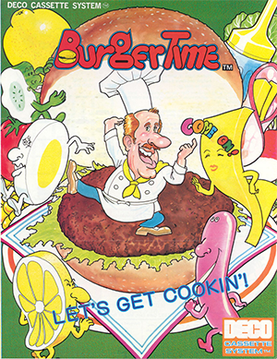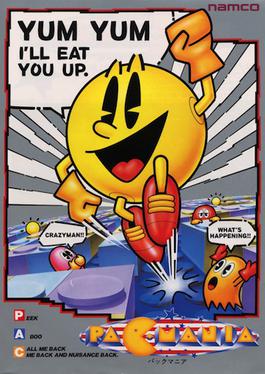| Super Taxman 2 | |
|---|---|
 | |
| Developer(s) | Brian Fitzgerald |
| Publisher(s) | H.A.L. Labs |
| Platform(s) | Apple II |
| Release | 1981 |
| Genre(s) | Maze |
Super Taxman 2 is a 1981 video game published by H.A.L. Labs.
| Super Taxman 2 | |
|---|---|
 | |
| Developer(s) | Brian Fitzgerald |
| Publisher(s) | H.A.L. Labs |
| Platform(s) | Apple II |
| Release | 1981 |
| Genre(s) | Maze |
Super Taxman 2 is a 1981 video game published by H.A.L. Labs.
Super Taxman 2 is a game in which the player must navigate four different mazes in this version of the original Taxman . [1]
Anthony Melendez reviewed the game for Computer Gaming World , and stated that "Despite the fact that maze-chase games have been overused, ST2 is a nice little game." [1]

MIDI Maze is a networked first-person shooter maze game for the Atari ST developed by Xanth Software F/X and released in 1987 by Hybrid Arts. The game takes place in a maze of untextured walls. The world animates smoothly as the player turns, much like the earlier Wayout, instead of only permitting 90 degree changes of direction. Using the MIDI ports on the Atari ST, the game is said to have introduced deathmatch combat to gaming in 1987. It also predated the LAN party concept by several years. The game found a wider audience when it was converted to Faceball 2000 on the Game Boy.

Pac-Man, originally called Puck Man in Japan, is a 1980 maze action video game developed and released by Namco for arcades. In North America, the game was released by Midway Manufacturing as part of its licensing agreement with Namco America. The player controls Pac-Man, who must eat all the dots inside an enclosed maze while avoiding four colored ghosts. Eating large flashing dots called "Power Pellets" causes the ghosts to temporarily turn blue, allowing Pac-Man to eat them for bonus points.

BurgerTime, originally released as Hamburger in Japan, is a 1982 arcade game developed by Data East initially for its DECO Cassette System. The player is chef Peter Pepper, who must walk over hamburger ingredients located across a maze of platforms while avoiding characters who pursue him.

Ms. Pac-Man is a 1982 maze arcade game developed by General Computer Corporation and published by Midway. It is the first sequel to Pac-Man (1980) and the first entry in the series to not be made by Namco. Controlling the title character, Pac-Man's wife, the player is tasked with eating all of the pellets in an enclosed maze while avoiding four colored ghosts. Eating the larger "power pellets" lets the player eat the ghosts, who turn blue and flee.
The action-adventure genre is a video game hybrid genre that combines core elements from both the action game and adventure game genres.

Dig Dug is a maze arcade game developed by Namco in 1981 and released in 1982, distributed in North America by Atari, Inc. The player controls Dig Dug to defeat all enemies per stage, by either inflating them to bursting or crushing them underneath rocks.

3D Monster Maze is a survival horror computer game developed from an idea by J.K. Greye and programmed by Malcolm Evans and released in 1981 for the Sinclair ZX81 platform with the 16 KB memory expansion. The game was initially released by J. K. Greye Software in December 1981 and re-released in 1982 by Evans' own startup, New Generation Software. Rendered using low-resolution character block "graphics", it was one of the first 3D games for a home computer, and one of the first games incorporating typical elements of the genre that would later be termed survival horror.
Super Pitfall is a 1986 side-scrolling platform video game for the Nintendo Entertainment System, NEC PC-8801, and TRS-80 Color Computer 3 published under Activision's license. Despite the title screen stating that it was developed by Pony Inc, the actual development of the NES version was handled by Micronics, with the PC-8801 version being developed by Pony Inc. while the CoCo version is credited as being "Programmed by Steve Bjork of SRB Software". The PC-8801 version released in November 1986, two months after the original release in September 1986, although this variant of the game was limited to single-screen platforming rather than side-scrolling.

Krusty's Fun House is a video game based on the animated sitcom The Simpsons.
A*mazing was an Australian children's television game show that aired between 16 May 1994 until 1998 on the Seven Network. It was famous for a relatively large and elaborate maze/obstacle course that was part of the show's studio set. A*mazing was hosted by James Sherry for the entire run of the series. A*mazing was produced at Channel 7 in Brisbane from 1994–1996 and then at Channel 7 in Perth from 1997–1998.

Wizardry: Proving Grounds of the Mad Overlord is the first game in the Wizardry series of role-playing video games. It was developed by Andrew Greenberg and Robert Woodhead. In 1980, Norman Sirotek formed Sir-Tech Software, Inc. and launched a beta version of the product at the 1980 Boston Computer Convention. The final version of the game was released in 1981.

Super Bomberman 2 is a video game developed by Produce! and Hudson Soft and released on the Super Nintendo Entertainment System. It was released in Japan on April 28, 1994, in North America later the same year, and in Europe on February 23, 1995.

Pac-Mania is a cavalier perspective maze game that was developed and released by Namco for arcades in 1987. In the game, the player controls Pac-Man as he must eat all of the dots while avoiding the colored ghosts that chase him in the maze. Eating large flashing "Power Pellets" will allow Pac-Man to eat the ghosts for bonus points, which lasts for a short period of time. A new feature to this game allows Pac-Man to jump over the ghosts to evade capture. It is the ninth title in the Pac-Man video game series and was the last one developed for arcades up until the release of Pac-Man Arrangement in 1996. Development was directed by Pac-Man creator Toru Iwatani. It was licensed to Atari Games for release in North America.
In video games, first person is any graphical perspective rendered from the viewpoint of the player's character, or a viewpoint from the cockpit or front seat of a vehicle driven by the character. The most popular type of first-person video game today is the first-person shooter (FPS), in which the graphical perspective is an integral component of the gameplay. Many other genres incorporate first-person perspectives, including other types of shooter games, adventure games, amateur flight simulations, racing games, role-playing video games, and vehicle simulations.

Fun 'n Games is a compilation video game developed by Leland Interactive Media and released for the Super NES and Mega Drive/Genesis platforms in 1993 and 1994. A game with the same name was released in 1995 for the 3DO Interactive Multiplayer, but it differs slightly in gameplay and was developed by Williams Entertainment Inc. The North American Super NES version of the game is considered to be one of the more rare games released for the console.

Drelbs is a maze game written by Kelly Jones for the Atari 8-bit family and published by Synapse Software in 1983. An Apple II port by Jonathan Tifft was released the same year. A Commodore 64 version followed in 1984 implemented by Miriam Nathan and William Mandel. The core objective is to move the walls of the maze to make boxes. Some reviewers found the overall collection of elements to be eccentric and unique.

Zenji is a puzzle game designed by Matthew Hubbard and published by Activision in 1984. It was released for the Atari 5200, Atari 8-bit family, ColecoVision, Commodore 64, MSX, and ZX Spectrum. Hubbard previously wrote Dolphin for the Atari 2600.

Taxman is a clone of Namco's Pac-Man written by Brian Fitzgerald for the Apple II and published by H.A.L. Labs, a firm he cofounded with Greg Autry, in 1981.